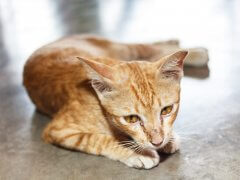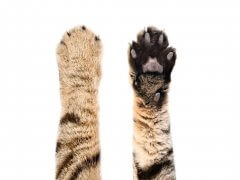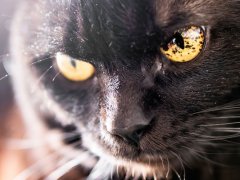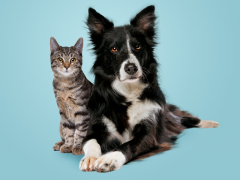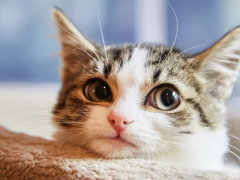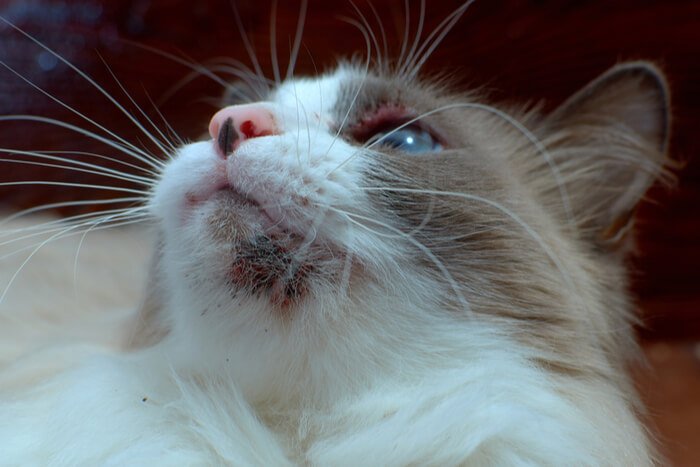
This article is about cat acne (also known as feline acne, chin acne, folliculitis or furunculosis). The aim of this article is to provide a simple, clear explanation about cat acne for cat owners.
Quick Overview: Cat Acne
 Other Names: Feline acne
Other Names: Feline acne
 Common Symptoms: Excessive greasy and crusty appearance to the area of the chin and sometimes lips. Blackheads or whiteheads may be seen. Can progress to hair loss, red irritated skin and oozing sores.
Common Symptoms: Excessive greasy and crusty appearance to the area of the chin and sometimes lips. Blackheads or whiteheads may be seen. Can progress to hair loss, red irritated skin and oozing sores.
 Diagnosis: Feline acne has a common appearance identified during an exam. However, a vet may sometimes wish to rule out other skin conditions through skin cytology samples, culture, or biopsy.
Diagnosis: Feline acne has a common appearance identified during an exam. However, a vet may sometimes wish to rule out other skin conditions through skin cytology samples, culture, or biopsy.
 Requires Ongoing Medication: Yes (topical therapy)
Requires Ongoing Medication: Yes (topical therapy)
 Vaccine Available: No
Vaccine Available: No
 Treatment Options: Topical treatment with wipes, shampoos, or mousses containing chlorhexidine, benzoyl peroxide, or salicylic acid. Antibiotic ointments. Severe cases may require oral antibiotics +/- a corticosteroid if very inflamed. Supplements containing omega fatty acids.
Treatment Options: Topical treatment with wipes, shampoos, or mousses containing chlorhexidine, benzoyl peroxide, or salicylic acid. Antibiotic ointments. Severe cases may require oral antibiotics +/- a corticosteroid if very inflamed. Supplements containing omega fatty acids.
 Home Remedies: Change any plastic food/water bowls to ceramic or stainless steel bowls.
Home Remedies: Change any plastic food/water bowls to ceramic or stainless steel bowls.
What Is Cat Acne?
Cat acne is not dissimilar to human acne in some ways but there are differences too.
In cats, as in humans, acne is a skin condition that develops when the hair follicles become plugged with oil and dead skin cells. In both species, these clogged pores are seen as blackheads and pimples, and continued infection of the blocked follicles leads to the full picture of acne.
In humans, acne is most common among teenagers, influenced by changing hormones, and in particular, raised androgens (male hormones).
In cats, the condition can be seen at any age: adolescent cats are not more prone to this than adults.
How Common Is Cat Acne?
Mild cases of cat acne are very common, with low-grade signs that may not even be noticed by owners (the skin is hidden under the fur). Advanced, serious cat acne is less common and it can be difficult to resolve.
How Do Cats Get Cat Acne?
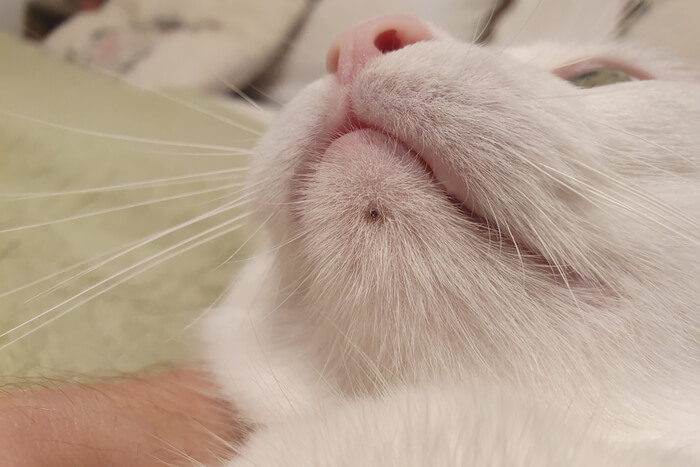
Cats most often develop acne around their large sebaceous glands, located on the chin, lips, and at the base of the tail.
Cat acne is linked to a particular type of gland in the skin, known as the sebaceous gland. Most of the sebaceous glands are attached to hair follicles, producing an oily secretion (known as sebum) that coats the hairs, making them shiny, waterproof, and flexible.
As well as these hair-based sebaceous glands, there are separate larger sebaceous glands on the chin, the lips, and the base of the tail, as well as some other places. These larger glands have specific names and a particular function: they play an important part in scent marking, which is an important cat social behavior.
This is why cats rub against people and objects in their home, pressing their chin, lips, head and tail base to mark these areas with scent-carrying secretions.
- The sebaceous glands under the chin are known as the ‘submental organ’. This is the area that is mostly affected by cat acne.
- The sebaceous glands at the base of the tail are known as the ‘supracaudal organ’. When this area is affected with acne-like changes, the resulting skin condition is known as “stud tail”. This condition will be discussed in a later article.
Cat acne starts when the chin sebaceous glands and surrounding hair-linked sebaceous glands become over-active, causing excessive secretion which appears as yellow or brown accumulations on the fur of this area.
The openings of the glands get blocked by this thick secretion, combined with excessive keratin, creating comedones (also known as ‘blackheads’). Bacterial infection of the blocked glands follows, leading to pustules and abscesses, along with general inflammation of the hair follicles (folliculitis) and the surrounding skin (pyoderma).
Symptoms of Cat Acne in Cats
Early signs of cat acne include excessive greasiness and discoloration of the skin in the area of the chin and lips. Comedones (blackheads) and whiteheads may be seen. As the condition progresses, bacterial infection of the hair follicles and sebaceous glands leads to folliculitis and pyoderma, with reddened, sore-looking, swollen skin that may be oozing pus.
Affected areas are painful, and they may be itchy, with the cat repeatedly scratching the chin and lips. There is often hair loss, with affected areas having a hair-free, shiny, reddened surface. The accumulation of secretions can cause dried, crusty, scab-like debris to accumulate.
Poor grooming can aggravate the condition because of the accumulation of discharges on the fur.
Causes of Cat Acne in Cats
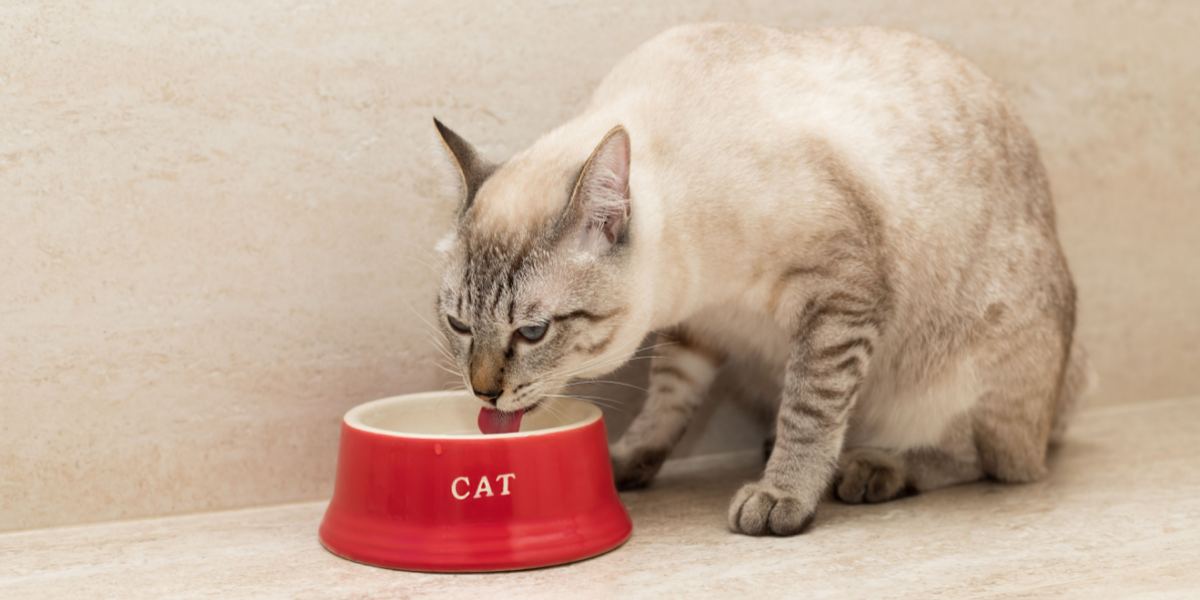
We haven’t clearly identified the causes of cat acne, but we do know of several factors that may contribute. Some cats, for example, may develop acne if they’re allergic to their food or water dishes.
The causes of cat acne have not been clearly identified, but factors that may play a role include:
- Over-production of secretions from the sebaceous glands for unknown reasons
- Genetics: the problem is more common in some breeds of cats like Persians
- Viral causes are suspected in some cases
- Allergies to certain items, such as plastic foo and water bowls, may be involved
- Irritant substances in the environment may play a role
- Food allergies may sometimes play a role
- Auto-immune disease may be involved in some cases
- Ringworm (a fungal infection) may underlie some cases
- Skin parasites (e.g. Demodex causing mange ) may sometimes be involved
Diagnosis of Cat Acne
If your DVM veterinarian suspects that your cat may have cat acne, the following steps may be taken.
1. Detailed History Taking
Your vet will discuss every aspect of your cat’s life and health care. There are other causes of the same types of signs as cat acne, and this history will help to differentiate the various possible causes.
2. Physical Examination
Your veterinarian will check your cat over carefully, noting any other physical signs of illness, searching for other conditions that may be linked to the skin disease.
3. Skin Tests
- Skin cytology (collecting a sample from skin lesions with sticky tape) allows the veterinarian to examine the cells on the skin under the microscope. Excessive numbers of bacteria (due to secondary infection) or yeasts (such as Malassezia) may be identified.
- Skin scrapings (using the edge of a scalpel blade pressed against the cat’s skin) may be carried out to search for parasites such as Demodex under the microscope
- Fungal culture may be carried out on a sample from affected skin to rule out ringworm
- Bacterial culture, with antibiotic sensitivities, may be carried out when a cat needs specific antibiotics to resolve deep infections
- A skin biopsy may be taken so that the changes in the skin can be examined by a histopathologist under the microscope: this is how a definitive diagnosis is made, but it is not always needed.
4. Other Tests
- It’s likely that your veterinarian may also carry out other blood work, including the usual panel of diagnostic tests, such as hematology (blood count) and biochemistry profiles, to confirm that there is no other underlying cause of your cat’s acne.
- Radiography (x-rays) may rarely be carried out to check for underlying bone or tooth disease that could lead to inflammation in the chin and lip area. Your veterinarian will advise you on whether or not such detailed investigations are indicated.
- In very severe cases, your veterinarian may suggest referral to a vet with a particular interest in dermatology.
How Much Does It Cost To Treat a Cat With Cat Acne?
It is impossible to estimate the cost of treating cat acne, as there is a wide range of different severity of the problem. A mild case may need minimal intervention, while a severe case may need ongoing investigations and treatments over many months. You should ask your veterinarian for a detailed estimate before agreeing to proceed with treatment.
Treatment for Cat Acne

In addition to addressing the underlying cause of your cat’s acne, treatment may involve regularly cleaning the affected area.
The level of treatment depends on the severity of the problem. Broadly, there are two types of treatment.
Topical Treatments
- Mild cases may respond to simple topical treatments, similar to human acne treatments, including antibacterial and cleanser shampoos, washes or wipes that may contain chlorhexidine, benzoyl peroxide, salicylic acid and/or ethyl lactate. A specific anti-bacterial ointment, mupirocin 2%, is sometimes applied twice daily. Other antibiotic ointments may also be recommended by your veterinarian.
- If there is an accumulation of discharges, it may help to bathe affected areas with a wad of cotton wool or a clean washcloth, using a warm solution of mild salty warm water (1 teaspoonful in a pint) or Epsom salts (magnesium sulphate) solution at , one and a half teaspoonfuls per pint). Soothing products such as aloe vera may be helpful, and other products like witch hazel have been suggested, but care needs to be taken that they do not aggravate irritation (e.g. if in an alcohol base).
- It makes sense to change from a plastic bowl to ceramic or stainless steel food and water dishes.
Systemic Treatments
- If skin tests suggest severe bacterial infections, systemic antibiotics may be recommended, ideally based on the results of antibiotic sensitivity testing. In cases with significant redness and inflammation, a corticosteroid such as prednisolone may be recommended by your veterinarian to dampen down an over-reactive immune system.
- Nutritional supplements such as essential fatty acids are useful, as they are for many skin problems, to optimise general skin health.
- Isotretinoin, also known as 13-cis-retinoic acid and sold under the brand name Accutane, has been used for human cases of acne, and has sometimes been recommended for very severe cases of cat acne that do not respond to standard treatments. However this is a powerful drug with potentially very severe side effects, so this can only ever be considered under direct veterinary supervision. The product is not licensed, and its positive impact on this disease has not been proven.
Monitoring and Prognosis
Visual examination of the affected areas of skin makes it easy to assess the progress of chin acne. The prognosis is generally good, with most cases responding well to treatment. A low grade, ongoing issue is common, and maintenance therapy (perhaps just topical treatments) is often needed.
Conclusion
Cat acne is a common skin condition affecting the chin and lips of cats. The problem resembles human acne, and while there are some parallels in causes and treatments, there are also many differences. A simple home treatment regime, involving shampoos and cleaning, may sometimes be enough to control this disease, but veterinary involvement is important in severe cases.
Frequently Asked Questions
How do you treat cat acne?
Topical treatment, using shampoos or ointments, is the first approach, with more advanced cases needing systemic prescription only medication such as antibiotics and anti-inflammatories.
How can I treat my cat's chin acne at home?
The simplest form of treatment is regular bathing (eg mildly salty water) and the use of anti-bacterial shampoos to clean affected areas of skin.
Does cat acne go away?
Most cases of feline acne resolve with treatment, but often a lower level of maintenance topical therapy (eg twice weekly cleaning) may be needed to prevent recurrence. Breakouts of this type of follicular dermatitis may happen occasionally, leading to the need to increase the level of treatment intermittently.
What causes cat acne?
The cause is partly genetic (some cats are more prone to this) perhaps due to a tendency to allergies or auto-immune disease. External factors may also play a role, including allergy to plastics or foods, as well as parasite, bacterial, viral or yeast infections, and even irritant substances in the environment.
